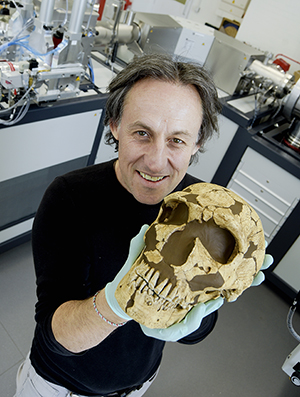What do we know about the Earth, and the species of humans that walked it 50,000 years ago? Archaeological scientist Tom Higham asks this question and more in his upcoming book The World Before Us, which we are delighted to announced has been acquired by Viking. World English rights were acquired from Joanna Swainson for the book which will explore how scientific and technological advancements have made profound discoveries about the history of human species possible, and allowed scientists to be more accurate in their predictions of how long ago these other humans lived. The World Before Us is set to be published in hardback in spring 2021.
50,000 years ago, we were not the only species of human in the world. There were at least four others, including the Neanderthals, who occupied Europe, the Near East and parts of Eurasia; the enigmatic Homo floresiensis, or ‘Hobbits’, from the island of Flores; and Homo luzonesis, found in the Philippines, and even more diminutive than the Hobbits at less than four feet high. And then there are the Denisovans, discovered thanks to cutting-edge science in 2010 in a cave in Siberia, named after a local monk called Dennis.
The implications of these – and future – discoveries for us today are profound. We know which human groups today share which ancestors’ genes, and the impact this has; for example, genes from Denisovans explain why some people cope better with living at high altitude, and Type 2 Diabetes may have been an evolutionary advantage for Neanderthals, who, in times of nutritional stress, may have needed to retain more blood sugar than their 21st century Homo sapiens-descendants.
Viking’s assistant editor Connor Brown said: “Fascinating on, among many other things, how we became the only humans on Earth and what it is like to be the person making a world-changing breakthrough in science, this is an expansive and peerlessly authoritative work with profound implications for our understanding of ourselves.”
Higham added: “I want to convey to the reader the sheer excitement of discovery in the science of human evolution, whether that is in the laboratory or at the point of a trowel in an archaeological site. In the last two decades our understanding of who we are and how we evolved to become the last kind of human on Earth has been revolutionised by new scientific methods and archaeological discoveries. In this book I want to tell these stories first-hand from the perspective of the actual researchers doing the work. I also want to describe the different groups of humans we now know inhabited Earth 50,000 years ago, how they were discovered, how they lived, and finally how they disappeared from the world.”
Tom Higham is a Professor of Archaeological Science at the University of Oxford. He has worked in Oxford since 2001. Prior to this he worked and studied in his native New Zealand.
He specialises in radiocarbon dating using accelerator mass spectrometry, particularly the dating of archaeological sites back to around 50,000 years ago. He has extensive research and collaborative links with dozens of archaeologists, geneticists, geologists and earth scientists from a range of university and research groups, and works on archaeological sites across Eurasia, the Americas, Australasia, SE Asia and the Pacific.
He has written more than 260 refereed journal articles in his career.His research work since 2004 has focused on the extinction of Neanderthals and the dispersal of modern humans across Eurasia between 50-30,000 BP. He is one of the team working at the important Russian site of Denisova Cave, where a new species of humans was found in 2011.
Read the full article in The Bookseller here.
